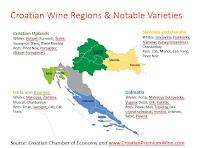In his honor, each November in the small historical town of Momjan, just north of Buje, the Feast of Saint Martin (“Martinje") is celebrated with the ceremonious ritual of baptizing wine. Merry wine-lovers gather in the local vineyards with actors dressed up in the roles of a judge, bishop, godmother and godfather of the wine and praise God with their witty prayers. The wine is then baptized and the first bottle is unlocked with the key to the wine kingdom - a corkscrew. The celebrations are accompanied by an abundance of delicious food and endless supply of wine, lasting until the early hours of the morning. The Aroma of Istria - Feast Day of St. Martin
 November 11th (12th in the Eastern Church) is the Feast day of St. Martin of Tours, and although he is the patron saint of France, St. Martin still receives devout reverence in Eastern Europe and the Balkans. In Croatia, Saint Martin is known as the protector of vineyards and winemakers, and Martinje marks the "cheerful traditional folk custom of symbolically translating must into young wine ('baptism of wine')". This celebration is particularly vibrant in the Istrian Peninsula as described in the block text above. Thus it is an appropriate two days to discuss the northernmost of Croatia's wine regions: Istria.
November 11th (12th in the Eastern Church) is the Feast day of St. Martin of Tours, and although he is the patron saint of France, St. Martin still receives devout reverence in Eastern Europe and the Balkans. In Croatia, Saint Martin is known as the protector of vineyards and winemakers, and Martinje marks the "cheerful traditional folk custom of symbolically translating must into young wine ('baptism of wine')". This celebration is particularly vibrant in the Istrian Peninsula as described in the block text above. Thus it is an appropriate two days to discuss the northernmost of Croatia's wine regions: Istria.Istria is rapidly developing as one of Croatia's key wine regions. It is located on the Istrian Peninsula in northwest Croatia (the northern end of the peninsula is part of south-western Slovenia and that county's Istra wine region). The Peninsula is heart-shaped with the coasts stacked with limestone rock and soils. The interior is hilly with foggy valleys and abundant microclimates - usually iron-rich soils and excessive sunshine moderated by coastal influences. Olive and fig trees compete with the over 4,000 hectares of vines planted in the region.
The most popular grape planted in Istria is the white Malvazija Istarska, however, Teran is a dominant indigenous red grape. It is a member of the diverse Refosco family: dark-skinned grape varieties native to the Venetian zone and neighboring areas. Wine from the Teran grape is generally earthy, full-bodied, and robust. And Croatians tend to pair Teran with Istrian smoked meat and game dishes.
 Vina Fakin is an Istrian winery located in the medieval town of Motovun -- where once the Celts and later Illyrians built fortresses or "a town in the hills" the Celtic translation of Motovun. The winery grows primarily Malvazija Istarska, Teran, and Muškat on 30 hectares in the surrounding hills encompassing several micro-climates. Winemaker Marko Fakin founded the winery in 2010 using the family vineyards. With that very first vintage, the Teran wine won a Croatian national competition as well as recognizing Marko as Winemaker of Year (Croatian Wine Dream Comes True Without Leaving One’s Homeland).
Vina Fakin is an Istrian winery located in the medieval town of Motovun -- where once the Celts and later Illyrians built fortresses or "a town in the hills" the Celtic translation of Motovun. The winery grows primarily Malvazija Istarska, Teran, and Muškat on 30 hectares in the surrounding hills encompassing several micro-climates. Winemaker Marko Fakin founded the winery in 2010 using the family vineyards. With that very first vintage, the Teran wine won a Croatian national competition as well as recognizing Marko as Winemaker of Year (Croatian Wine Dream Comes True Without Leaving One’s Homeland).I recently purchased that wine's successor, the Fakin Teran 2019 ($29) from Croatian Premium Wine Imports in anticipation of Martinje. The wine is delicious -- full-bodied and robust, specifically, fruit-forward dark cherries, then chocolate, and firm yet approachable tannins. Can't wait to visit one day. Cheers.
